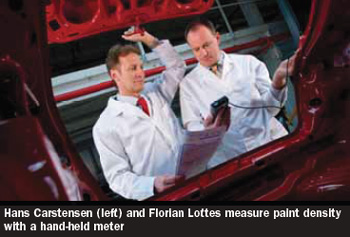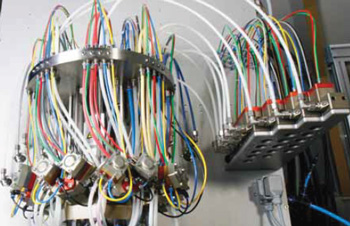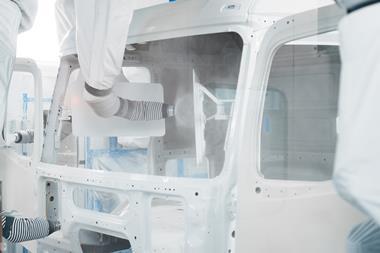Audi uses a mix of robot and manual spraying, matching and inspection on mixed material substrates to give its customers a range of colours and effects, as two of its heads of paint operations explain
Selling cars in the ‘mid-premium-sports’ sector of the market combines the challenges of satisfying increasingly sophisticated customers’ expectations with the need to achieve the economies of scale needed to return profits on the massive investments that accompany series production.
Audi cars are expected to outperform not only the competition from vehicles outside the VW Group but also attract customers who might otherwise look to the sports range offerings from VW, Seat or even Skoda, for an exciting and ‘individual’ car.
The company’s bold styling and innovative dynamics are matched by a high level of finish, and its buyers have come to expect a wide choice of exotic colours and paint technologies, including pearls, dark metallics and some non-metallic colours that only look good when finished flawlessly.
Add to this the demands of preparing and painting aluminium and aluminium/steel mix bodies and you have some considerable challenges for the paintshop.
 I spoke with Dipl.-Ing. Hans Carstensen, General Manager of Paintshop Planning/Process Engineering (HC) and Dipl.-Ing.
I spoke with Dipl.-Ing. Hans Carstensen, General Manager of Paintshop Planning/Process Engineering (HC) and Dipl.-Ing.
Florian Lottes, Head of Paintshop A3/TT/Components (FL) and I started by asking about the special challenges of coating aluminium, particularly in the pre-treatment stages:
FL: On aluminium, it is fairly straightforward if you have a single aluminium line, as we have in Neckarsulm with the A8 and the A2.
The challenges arise when you mix materials; aluminium and steel because for steel you must use a phosphating process, and the best way for the aluminium parts is to use no phosphate.
We have had some problems with some aluminium parts combined in assemblies with steel, and now we have even more steel and aluminium mixed parts with the TT here in Ingolstadt. These bodies run through the same line as the A3, which has no aluminium parts. Now we are working on the A5, this has some aluminium parts and also the Q5 that has aluminium parts – many combinations and many variables!
The problem we have is getting a smooth surface on both aluminium and steel; with the phosphate process which we ran until the middle of last year, we had phosphatization on the aluminium parts and the result was a lot of sludge in the process, aluminium sludge which we had to treat as waste.
HC: You take off a certain amount of the aluminium surface (by oxidization) that we remove from the baths because it is like poison for the steel parts. The more aluminium you put in, the more sludge you get. There is a technical limit to how much you can tolerate in this process. To run a robust process, you must work to a limit of between 5% and 20%.
We have considered but not tried plasma-treatment of the aluminium; we simply wash the aluminium parts, to remove forming oils and grease.
The construction of Audis is famous for its clever use of aluminium castings, extrusions and sheet. Do you get differing sludge rates with the differently formed parts?
FL: It is usually not a problem, we treat all the parts the same, what we are doing now is changing the process to a two-step process; this is where we combine the old 100% aluminium process and use a modern phosphatization system; with the addition of a polymer coating, there is no phosphatization of the aluminium. We put a microscopically thin zircon-bound layer in the passivation stage. This avoids phosphate crystals ‘sticking’ to the aluminium.
HC: Where we do have a problem with different aluminium constructions is in the differential expansion of castings, extrusions and sheet in the curing ovens. We have virtual modelling programme for this and for e-coat coverage. We work on 5% per cent correction of these results when we go to actual applications. We use CADFEM (through DELMIA) software for modelling component behaviour in the ovens.
Powder clearcoat was being promoted as the next big thing a few years ago, and is being used by BMW. What is your approach?
HC: We have chosen to stay with liquid systems. In the early 1990s, we worked with BMW, Dürr and some paint suppliers on a joint project. At the end of this project, BMW decided to go the powder route, we thought that there were still some quality problems, particularly with special colours as powder can come out slightly yellow and this changes the colour of the basecoat. At the time we were building our new paintshop here at Ingolstadt and we considered the liquid powder (slurry) system used by Daimler at Rastatt, alternating that system with a water-based clearcoat. If at any time we come under greater environmental pressures, we might consider going to this; at present we use a solvent-borne 2K clearcoat system. At present the limit under German government legislation is 35 milligrams per vehicle, at the moment we are running at about 20 milligrams.
Overspray: how do you manage it and the resulting waste?
HC: Using electrostatic painting, we have very few problems with overspray, 10 or 15 years ago we had a lot more of it. At the moment a fuller recycling process does not make sense; we tried this with the primer materials a few years ago and we found that it was not cost-effective. Our suppliers can use this paint waste only for very low-quality applications, they cannot deliver it back to us and it generally gets used for household paint.
FL: For us reusing this material would not make sense as we have four primer colours so it would be hard to use a mixture of all the waste paint – which would come out as brown! Wet-on-wet/three-wet paint systems. What is the Audi view?
HC: We don’t have it at present. Within the Volkswagen Group it is being trialled in some plants but the problem we have at present is that the colours we use here at Audi are not feasible with the three-wet process.
This is due to the wide use of metallics and other special effect paints.
We use up to four layers on some of the special effect orders, especially at Neckarsulm for Lamborghini, where we paint Gallardos with some very special colours, including the Arancio Borealis – an orange colour that demands very high process quality.
In the whole Volkswagen Group, we tend to use three-wet only for the smaller cars with simpler paint options. FL: It mainly saves energy but what rules against it is that you must have every colour ready and waiting to be used in the wet-on-wet process and since Audi is offering what ever colour the customer wants, the process makers, and ourselves, cannot develop each colour in this process – often just for one car.
Environmental considerations – what is special here at Ingolstadt?
We are very proud of our special ‘chimney system’, which looks different to other OEMs paintshops; it has very sophisticated heat recovery programmes; all the hot air that runs through the paint booths goes through a heat recovery system.
When you built the new paintshop here at Ingolstadt, how was the construction allotted – how much Audi and how much integrator etc?
HC: We built the paintshop in the middle of the 1990s and things were very different then.
We held a concept competition with Eisenmann, Tai- Kisha, Dürr, Trinity, ABB and Air Industrie. We drew up the specifications and chose Dürr for the whole contract, including the building works.
Nowadays, we would do this project differently, we have the capacity in-house to choose the equipment from the market’s offerings, design the layout ourselves, and the building would be made under a separate contract with a facilities builder. The paint equipment providers do not want to carry out the building works anymore as they can lose a lot of money in estimating a major paintshop project which over-runs in time and complexity. Instead of using one major supplier as we did when the Ingolstadt paintshop was built, we would now have maybe four suppliers and Audi would make the coordination.
Chemicals – how early do you involve the suppliers when planning a line?
FL: We integrate the chemical supplier at the project team stage.
For example when we planned a new pre-treatment system, Henkel and Chemetall have to work with us to confirm the suitability of their products to our new system. This gives us flexibility in our supply line of chemicals. How do you choose between PPG, Henkel and Chemettal’s pre-treatment systems?
FL: We made a technology trial in our pre-treatment and phosphating area, we cleaned out the tanks and then tried Henkel and Chemetall materials. We ran a few cars through each chemical; when they come out of the system, they did look very different. One gives a slightly different colour to the other, and they both darkened both the aluminium and steel components considerably. We were particularly interested to see if the darkening would affect our colour matching, in fact it was no problem. They just looked a bit alarming; one treatment came out quite blue and the other quite green!
What is your procurement cycle on chemicals; how often do you review and ask for new quotes etc?
HC: We go through a review process together with the supplier every six months, examining any problems and our wants.
FL: It is not just the quality of the materials we review, but also the working practices; how we work together more effectively.
The fabled primerless paint process – a dream or reality?
FL: We are testing primerless application but it has its challenges – you are able to see every sanding mark and blemish on the body. We are also running accelerated aging tests on built-up cars, giving them extreme UV exposure etc. We should get these results before the end of 2009 and if the results look good, we will try it.
Manual painting and other process – how much is still in place at Audi?
FL: We have automated most of the paint process; what we are still doing manually is the primer coat on the door shuts, hood shuts and inside those panels. We have a project underway to do this with automated processes; we will start this first in Neckarsulm but in the present economic climate, it is hard to make the investment.
HC: We still have sealing application on doors and bonnets on the steel cars carried out manually, we don’t do any sealing in these areas on the aluminium bodies. This is an area were we are testing robots with our colleagues in the Volkswagen Group to perfect the automation of the process. The testing of this project should be finished this year and if the budget is available, we will try to implement this as soon as we can.
Wax cavity treatment – do you spray selectively or flood the cavities?
FL: We have a patented system from the Volkswagen Group in which we inject hot wax, flood the whole cavity and then recover the excess, this ensures complete coverage. We spray the inside of the doors on the steel cars but not the bonnets and trunk lids; these are already well protected well by the e-coating and zinc plating.
HC: The system we use, flooding and then draining the cavities, is very economical compared to other OEMs; because it is applied hot, it is very thin and flows well. We estimate that we use Ikg less per car than our competitors. We use all recovered wax, and we continue to recover the wax after the body has left the wax injecting station, using recovery trays and channels combined with underbody heating elements.
What are you using to separate colours and to circulate paint 24 hours a day – do you use the ‘pig’ system for all the lines?
FL: We have one system for special colours where we use the pigs in the paint delivery tubing but for the ‘fixed’ colours we have 16 paint lines per spray booth so every colour has its own line that circulates constantly.
HC: In downtimes, we slow the circulation down using many different energy ‘maps’ to make the best energy savings possible. How do you match car colours and hang-on parts that are often made and painted in different locations?
FL: First we have a small paintshop here (at Ingolstadt) for the small plastic parts and we do all the colours in a special spraybooth. Bumpers for series production cars come from the supplier already painted. For special colours, these bumpers go through the ‘custom’ spraybooth also. We match the colours by spectrometer but also optically – they have to match!
We check 100% of cars when we start running a new colour (in series production). Once the process is stable, we switch to around 10%. This is integrated on the line using hand-held systems. We have considered using robot systems as they do at BMW but we have not tried this yet.
If you had a ‘dream budget’ - unlimited money, what would you spend it on?
HC: We would like some more automation but we would retain some manual paint operations to keep the flexibility – otherwise, with a fully automated operation, you have to re-programme robots etc for every change in the vehicles.
 Working with the University of Ingolstadt and its primer supplier, Hemmelrath, Audi is trialling an on-line primer mixing system. This will produce custom-coloured primer for underbonnets, removing the need for topcoat and clearcoat and avoiding the use of up to 25 different primer colours. The Promera mixer uses dosing techniques found in plastic moulding and has a 2500 rpm mixing head with a stirrer chamber of just 2 cc capacity, for fl exibility and to prevent cavitation.
Working with the University of Ingolstadt and its primer supplier, Hemmelrath, Audi is trialling an on-line primer mixing system. This will produce custom-coloured primer for underbonnets, removing the need for topcoat and clearcoat and avoiding the use of up to 25 different primer colours. The Promera mixer uses dosing techniques found in plastic moulding and has a 2500 rpm mixing head with a stirrer chamber of just 2 cc capacity, for fl exibility and to prevent cavitation.





































